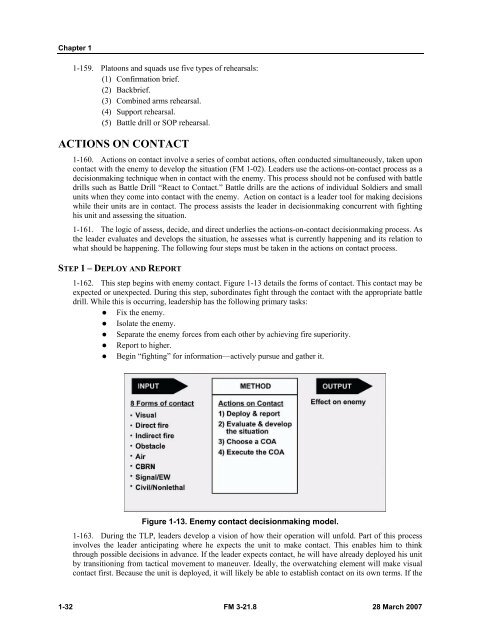Infantry Rifle Platoon and Squad - Sakai
Infantry Rifle Platoon and Squad - Sakai
Infantry Rifle Platoon and Squad - Sakai
Create successful ePaper yourself
Turn your PDF publications into a flip-book with our unique Google optimized e-Paper software.
Chapter 1<br />
1-159. <strong>Platoon</strong>s <strong>and</strong> squads use five types of rehearsals:<br />
(1) Confirmation brief.<br />
(2) Backbrief.<br />
(3) Combined arms rehearsal.<br />
(4) Support rehearsal.<br />
(5) Battle drill or SOP rehearsal.<br />
ACTIONS ON CONTACT<br />
1-160. Actions on contact involve a series of combat actions, often conducted simultaneously, taken upon<br />
contact with the enemy to develop the situation (FM 1-02). Leaders use the actions-on-contact process as a<br />
decisionmaking technique when in contact with the enemy. This process should not be confused with battle<br />
drills such as Battle Drill “React to Contact.” Battle drills are the actions of individual Soldiers <strong>and</strong> small<br />
units when they come into contact with the enemy. Action on contact is a leader tool for making decisions<br />
while their units are in contact. The process assists the leader in decisionmaking concurrent with fighting<br />
his unit <strong>and</strong> assessing the situation.<br />
1-161. The logic of assess, decide, <strong>and</strong> direct underlies the actions-on-contact decisionmaking process. As<br />
the leader evaluates <strong>and</strong> develops the situation, he assesses what is currently happening <strong>and</strong> its relation to<br />
what should be happening. The following four steps must be taken in the actions on contact process.<br />
STEP 1 – DEPLOY AND REPORT<br />
1-162. This step begins with enemy contact. Figure 1-13 details the forms of contact. This contact may be<br />
expected or unexpected. During this step, subordinates fight through the contact with the appropriate battle<br />
drill. While this is occurring, leadership has the following primary tasks:<br />
• Fix the enemy.<br />
• Isolate the enemy.<br />
• Separate the enemy forces from each other by achieving fire superiority.<br />
• Report to higher.<br />
• Begin “fighting” for information—actively pursue <strong>and</strong> gather it.<br />
Figure 1-13. Enemy contact decisionmaking model.<br />
1-163. During the TLP, leaders develop a vision of how their operation will unfold. Part of this process<br />
involves the leader anticipating where he expects the unit to make contact. This enables him to think<br />
through possible decisions in advance. If the leader expects contact, he will have already deployed his unit<br />
by transitioning from tactical movement to maneuver. Ideally, the overwatching element will make visual<br />
contact first. Because the unit is deployed, it will likely be able to establish contact on its own terms. If the<br />
1-32 FM 3-21.8 28 March 2007

















